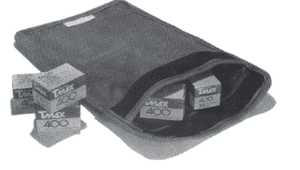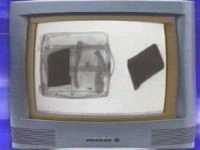




Having shot hundreds of rolls of film at Walt Disney World over the years, I am often asked by friends for advice on film and camera choice, photographic techniques, and especially how to transport film safely when flying. Although I'm not a professional photographer, I have done research on the subject by interviewing professionals and surfing the internet for relevant information. This is what I have found:
 Film is basically a strip of clear acetate or polyester (called the base) coated with layers of light-sensitive chemicals (called the emulsion). When light strikes the film, it changes the chemical nature of the emulsion. Once developed, the emulsion will change colors and densities depending on the color and intensity of the light which struck it.
Film is basically a strip of clear acetate or polyester (called the base) coated with layers of light-sensitive chemicals (called the emulsion). When light strikes the film, it changes the chemical nature of the emulsion. Once developed, the emulsion will change colors and densities depending on the color and intensity of the light which struck it.
But the chemicals in the emulsion are also sensitive to x-rays; when x-rays strike the emulsion, it is chemically changed in the much the same way as when it is struck by light. Thus, exposure to x-rays will cause the developed film to have a 'fog' effect; the colors will be washed out and dull, looking as though the pictures were shot through a heavy fog. The more x-ray energy that strikes the film, whether because of more powerful exposure or through repeated exposure, the lighter the film will get, until finally there will be no pictures left at all.
Additionally, film is more or less sensitive to both light and x-rays depending on it's ISO speed rating. The higher a film's ISO number, the more sensitive to light and x-rays it is, and the easier it will be fogged by exposure to x-ray energy.
This leaves you with one obvious option: don't let your film be exposed to x-rays.
 There are two places in the airport where your film might be x-rayed. One is inside your checked bags, which are always scanned by extremely powerful x-ray machines before being loaded onto any plane. The x-ray machines used to scan checked bags today are so powerful that they will totally fog any speed film with only one exposure.
There are two places in the airport where your film might be x-rayed. One is inside your checked bags, which are always scanned by extremely powerful x-ray machines before being loaded onto any plane. The x-ray machines used to scan checked bags today are so powerful that they will totally fog any speed film with only one exposure.
 The second place where film might be exposed to x-rays is at the security checkpoint. All carry-on bags are placed on a conveyor belt which takes them through an x-ray scanner, allowing the security people to see what is inside them. Because these x-ray scanners are used in areas where there are a lot of people, they are much less powerful than the x-ray scanners used on checked baggage. These carry-on bag scanners are, however, still powerful enough to fog your film under the right circumstances. Film of ISO 400 or slower will be fogged by only 5 exposures in these machines; film of ISO 800 or faster can be fogged by only one exposure.
The second place where film might be exposed to x-rays is at the security checkpoint. All carry-on bags are placed on a conveyor belt which takes them through an x-ray scanner, allowing the security people to see what is inside them. Because these x-ray scanners are used in areas where there are a lot of people, they are much less powerful than the x-ray scanners used on checked baggage. These carry-on bag scanners are, however, still powerful enough to fog your film under the right circumstances. Film of ISO 400 or slower will be fogged by only 5 exposures in these machines; film of ISO 800 or faster can be fogged by only one exposure.
As American airports upgrade their security equipment and procedures over the next few years, thanks to Osama bin Laden and the events of September 11, 2001, x-ray scanners used on both checked and carry-on luggage will become even more powerful, increasing the likelihood that your film will be fogged and ruined if it is scanned.
First, and I can not stress this enough:
From friends, family, and strangers over the internet, you may hear hundreds of stories of people who packed their film in checked bags and had no trouble. These are anecdotal; for every one person who loudly proclaims, "I stuck my head in the oven and didn't get burned!", you will find ten more whose heads were baked like potatoes. Take the safe route; keep your film out of your checked baggage.
Likewise, you will likely hear many stories from people who pack film in their carry-on luggage and have no problems with ruined or fogged film. This is certainly possible; it takes several exposures from most carry-on scanners to damage film of 400 ISO or lower. Film higher than 400ISO can be damaged or ruined by only one exposure. But as airports upgrade their scanners to more powerful units over the next few years, it becomes more likely than ever that even slower speed films will be damaged by just one exposure to x-rays. Thus, it's a good idea to take your film out of your carry-on luggage before it goes through the x-ray scanner.
 Not to worry, there is a simple technique that will solve all of your film transport and inspection problems.
Not to worry, there is a simple technique that will solve all of your film transport and inspection problems.
All you need is a large, clear, plastic bag. I use 1-gallon Ziploc or Hefty zipper-style food storage bags, which are big enough to hold as many as 25 or 30 rolls of 35mm film. Put your film into one of these bags and pack it on the top of your carry-on bag, in a spot that makes it easy to access. While in line to go through the metal detector, take your film bag out and hand it to one of the security screeners, and ask, "May I have this hand inspected, please?"
Disposable cameras should be removed from their outer box and inner sealed plastic wrap to allow the TSA screener direct access to the camera itself. Do this before you pack them in your Ziploc bags.
Security at all U.S. airports is now being provided by the Transportation Security Administration, an agency of the U.S. Department of Transportation. TSA personnel nationwide are all given the same training and use the same procedures, meaning that, in theory, all security people at all U.S. airports will react the same way when asked to hand-inspect a bag of film: they will take the film, hand-inspect it, and give it back to you after you pass through the metal detector, all without batting an eye.

 Photographers have been using small lead bags to protect their film from x-ray exposure for many years. These bags have worked well in the past, but several factors make them obsolete now.
Photographers have been using small lead bags to protect their film from x-ray exposure for many years. These bags have worked well in the past, but several factors make them obsolete now.
First, the x-ray scanners in U.S. airports are getting more and more powerful these days. X-ray scanners used on checked bags will actually penetrate the lead film bags and ruin film anyway. You can double-bag your film and perhaps protect it, but an object that the x-rays can't penetrate is considered a suspicious object (after all, it could be a bomb!) Baggage screeners will do two things when they see a suspicious object in luggage: they will first increase the intensity of the x-rays, and second, pull the bag out for a hand-inspection. This can cause your flight to be delayed, or cause you to be detained and searched yourself, since it is your bag with this suspicious object in it. This applies to both checked bags and carry-ons.
My advice is, save yourself the potential trouble by not using one of those bags to begin with.
Here are some links to web pages with more information on this topic.
This is pretty self-expanitory to me. I recommend that you print this page, highlight the relevant passage, and carry it with you in your film bag, just in case you run into a TSA security screener who is having a bad day.
This is the section actually dealing with screening photographic equipment: Code of federal Regs on X-rays (PDF)
And this is a link to the CFR home page on the web: Code of Federal Regulations

Send e-mail to the
Last Revision: 2009-07-04